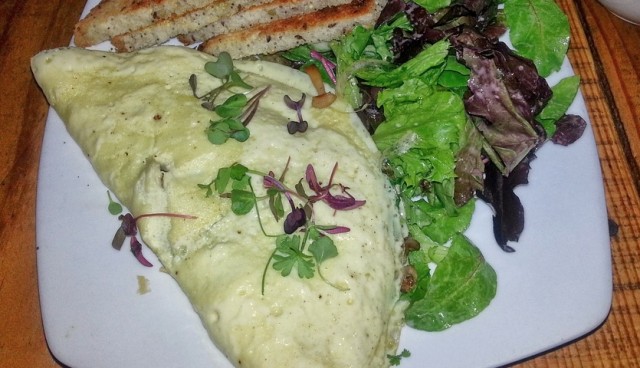This post may contain affiliate links.
James and I were out for breakfast recently. A farm to table restaurant, with a focus on local, fresh and in-season ingredients. They had a section on the menu for “healthier” options. This is always an amusing section of any menu for me to read. Sure enough, the omelets listed in the “healthier” section were made with egg-whites only.

I see this all the time, and it disappoints me. It goes to show that in general, we’re just not keeping up with current research on nutrition.
For several decades, we were all led to believe that dietary cholesterol raised our blood cholesterol levels which put us at risk of heart disease. So, we all started thinking eggs = bad. Though, we were assured, not the WHOLE egg was bad. The cholesterol is in the yolk (along with all the nutrition). And so the whole “egg-white omelets as a ‘healthier’ option” was born.
Turns out it was all a load of hooey. More recent research shows that when you eat more cholesterol, your body produces less. So, your blood cholesterol eventually will balance itself out, or just slightly increase. We had that one so wrong we now know eating eggs may actually decrease your risk for heart disease.
So, thanks to modern research, we’re a little nutrition smarter. We’ve learned eating eggs regularly really doesn’t raise LDL cholesterol levels in a harmful way that will increase heart disease risk factors…at least in MOST people. There is a very small percentage of people, called “hyperresponders” who really do have to restrict dietary cholesterol. Luckily, odds are you aren’t one of them.
And so now, with THAT tangent out of the way, here we are in the next part of my Living Well series. Limb #4: Disciplined Eating.

I should probably admit I’ve been dreading this one. Not because I don’t find nutrition important. It is. It is VERY important. But because there’s so much contradiction out there, even within the scientific community, that I can honestly say I’m just not sure WHAT a truly healthy diet looks like. So if you were reading in hopes I’d just TELL you what to eat on your quest to live well, prepare to be disappointed.
I think we can roughly agree that a balanced diet made up of real foods, not processed and chemical-laden, is a good idea. But from there, things get tricky. Dietary needs aren’t a one-size-fits-all kind of thing. Take the whole low-carb trend that’s pretty popular right now. While a low-carb diet could help a diabetic, it might cause side-effects in someone else. So, even though there seems to be loads of research saying that low-carb is a healthy way to eat, there’s also research saying it isn’t. So, how are we supposed to work with that?!?
And then there’s all the misinformation out there in the name of making a buck. I’m sure you’ve heard of the Wheat Belly books by Dr. William Davis? Even after scientists and health organizations openly debunked his claims, and one blog even claimed to catch him knowingly perpetuating false information, the books continue to sell like hotcakes. And that book is just one example of irresponsible information. Those of us attempting to write about nutrition depend on research to tell us what to tell you. Trouble is, in the US, nutrition research for governing bodies is in direct conflict with agribusiness most of the time. This is what we’re up against.

So instead of focusing on WHAT we should be eating, I’m not even going to go there. I’m quite certain the minute I do, the research will change and I’ll have to sack this whole article. Besides, there’s a whole other critical side to nutrition that needs addressing… and that’s how MUCH we eat.
Portion Control, Portion Control, PORTION CONTROL!
Remember in earlier parts of this article series when I discussed the Mind-Body Disconnect, and how it thwarts our wellness efforts? Overeating is another byproduct of that. We have got to get control of how much food we eat in a day if we want to lead a wellness-focused lifestyle, but when there’s a disconnect between our mind and our body’s needs, we’ve got a big problem. The mind eats to meet its own instinctive needs, ignoring what it consciously knows would be healthier eating behavior, and as a consequence the body suffers.
Overeating occurs when you consume, over the long term, more food than your body needs. It actually triggers a couple different unfortunate cycles. Extra insulin gets produced in the pancreas so it can process the sugar overload and remove it from your bloodstream. Problem is, your pancreas doesn’t stop making insulin until the brain feels the blood sugar levels are safe. But with overeating, this becomes an inefficient process. By the time the brain decides to cut off insulin production, often times too much sugar gets removed. And that’s just one negative effect. Consistently overeating also causes the neurological signals that tell the brain when you’re full to malfunction. So you stop realizing you’re full until you’re beyond full. It almost becomes like a yo-yo effect. You overeat, but the brain doesn’t tell you you’re full, so you continue to eat, but that just worsens the already malfunctioning signals. So you’re left with feelings of hunger that shouldn’t be there. And what do you do about it? You eat!!!

Chronic overeating will eventually catch up with you. On a small scale, it makes us sluggish, bloated, gives us digestive troubles, messes with sleep, and can cause depression. Much worse than that, it leads to obesity and all its associated health risks, including diabetes, hypertension and heart disease.
So we’ve got the body battling the brain and too much tasty food everywhere, what are we to do? I don’t want to downplay the difficulty of implementing portion control by telling you to simply eat less and all will be well. It is way harder than that, especially when tasty food is SOOO wonderful. So, instead I hope you’ll try your best to be mindful about your nutrition choices. Remember you’re not eating for your Present Self, you’re eating for your Future Self. The one who desperately hopes for health, strength, and vitality. Your body, the deaf, dumb, and blind partner of yours, depends on you to make the best eating choices you can. When you do, your body will respond by thriving. So it’s a give and take. You give healthy food as fuel to the body in reasonable amounts, and the body rewards you with health back in return.
So once again, my advice to you is the same as it’s been all along this article series: Nurture the mind-body relationship, my friends…it’s the key to wellness.

As for getting control of your portion sizes, here are a few of my favorite tactics:
1) Meal Prepping. For people REALLY struggling with portion size, I recommend being very strict as you prep your meals. Only make enough for one serving for each person in your family, and know what a realistic serving is. Making enough for seconds means your willpower will have to go to battle against your malfunctioning hunger signals…and it’s best to eliminate the option of seconds instead of test the outcome of that battle. If you do make extra, put the leftovers away before you even serve the meal. That way, once again, eating seconds because you *think* you’re still hungry won’t even be an option.
2) Snack Prepping. Portion your snacks out before you store them away. A good example of this is nuts. If you buy a big bag of almonds, for example, measure out a single portion size into snack baggies. Do this with everything you have a weakness with!
3) Staging. If you’ve got treats in the house, or any food that you tend to overeat, get them out of sight. Don’t leave them out on the counter, or towards the front of the fridge, that’s the worst thing you can do. We eat with our eyes first, so instead of having the treats where you can see them, instead put fresh fruit or veggies front and center. It’s harder to overeat on apples than it is on brownies.
4) The Veggie Trick: Besides being the healthiest thing out there, veggies are very low in calories, so you can trick yourself into feeling more satiated by padding all your meals with loads of veggies.
5) Don’t Buy Junk Food You Know You’ve a Weakness For: When you stock up on groceries, if you don’t buy your favorite junk foods, you won’t have the option to eat them, or to OVEReat them.
6) The 80% Rule: Learn to gauge when you’re not quite full yet, and use your tapas to stop there. Since it takes a while to get the signal you’re full, stop at around 80% full, and just hang in there for 30-45 minutes. The “full” feeling will come. This is a hard strategy to master and takes time, but once you do, you’ll be on top of the whole portion-control battle.
So, there you are, a few strategies to help you with overeating, hopefully you’ll keep them in mind.
I’d also like to encourage you to continue educating yourself on current research in nutrition so you’ll be better able to make informed choices for yourself. We’re bombarded with subtle and not-so-subtle information on healthy eating, and without seeing the research firsthand, it’s hard to differentiate truth from misinformation. The website nutrition.org is run by the American Society for nutrition and is a good starting point.
As always, I’d love to continue the discussion down in the comments. Let me know your thoughts, questions, and suggestions!
Rooting for you,
xoxo Stef











Yes the old eat to ride, ride to eat mantra does not work. After all one can always eat more than one can ride (or any other exercise). Losing 35 lbs is the best cycling equipment I ever purchased (still have 15 lbs to go).
Very true. Many times I’ve started with a brand new personal training client and they actually gain weight their first month of training. They were rewarding their workouts by allowing themselves to eat more. Exercise (unfortunately) doesn’t give us a free pass at the buffet line, ya know? Great job on the 35lbs, wow. That takes discipline. Sounds like you’ve found strategies that work for you. If only we could bottle that discipline and sell it!!!!
Thanks Travis and Stef for the info on types of LDL and “vegetable” oils (yikes!). Nutrition information is so contradictory, it’s hard to know what to do sometimes. I stick to the basics, use whatever “health hacks” work, and think of it as a process of improvement. No failures, just opportunities to do better next time. Some of my guidelines and hacks:
DRINK MORE WATER – This was easy once I started serving water in a nice glass with ice cubes, a squirt of lemon or lime, and a citrus slice. In cold weather I use hot water and citrus in my favorite mug. Also, I never leave the house without a water bottle.
EAT MORE VEGETABLES – Easy changes: a daily green smoothie and snacks of baby carrots and red pepper strips dipped in hummus. Next goal: Having veggies make up 50 percent of my meals.
EAT FRUIT FOR DESSERT – Go-to cold treat is frozen cherries (sometimes frozen grapes). Hot treat is spiced sautéed apples. Also keep super-sweet tangelos in fridge.
LIMIT ACCESS TO PROBLEM FOODS – Rather than relying on willpower (because I hear voices in the pantry), I restrict access to junk food or binge foods. The journey of ice cream in my two-person household: Half gallons equalled no portion control and binge eating. Next, Klondike Bars (6 to box) – portion control but too many portions available. Next, Dove Bars (higher quality, higher cost per bar, 3 to box) – portion control and limited portions, but boxes purchased too often. Finally, ice cream banned from house – can only be eaten at ice-cream shop no more than once per week after bike ride, but now enjoyed with ZERO guilt.
Very good guidelines to live by! It’s a daily battle for sure, but one that comes with great rewards! Stick to it, JL!
Finally, someone that talks about nutrition actually reads the studies and not the “conclusions” of people whose livelihood depends on the “right” conclusion… aka biases…i recently had blood work done and my cholesterol was “high” per the blood work. Of course, the medical industry instantly wants to put you on statins, which every study out there shows that they are worse than the most elevated cholesterol you can imagine. I am one of those people that when something impacts me, I do research… lots of research, so that I can make decisions based on facts not what “they” say. One thing many people don’t know about concerning LDL (the “bad” cholesterol) is that there are two types (A & B). Type A is large “fluffy” cholesterol that has zero impact on you, the other is small “heavy” cholesterol, these are the ones that 1) embed in your artery walls and cause plaque build up and 2) are made worse by processed UNSATURATED vegetable oils! Basically, this cholesterol is made worse by the very “solution” the medical industry advises when talking about diet! And you won’t know what type you have with the regular bloodwork tests they give, you have to request to have the test done that measures the size of the cholesterol.
This is just the tip of the iceberg when it comes to the complete misinformation not only published but adhered to by the very people who are supposed to know (doctors, dietitians, etc).
If you want any of the info I have found, let me know! And on a side note, we start our full time in the RV May 26th! Hence, how I found your blog… the wife is worried about staying in shape while RVing… so am excited to find your blog!
That was a great explanation of LDL. It’s how we got it all wrong before. We looked at LDL as a whole and didn’t weigh in for the fact that large LDL particles are not only harmless, might even be protective. It’s only the small LDL particles that have any correlation to heart disease. We have to stop looking at LDL levels as a whole. And I definitely agree about processed seed oils (like soybean oil, sunflower oil, corn oil, canola oil, cottonseed oil, safflower oil, etc.). They are called “vegetable” oils even though they aren’t vegetables, and are an unnatural product that shouldn’t be confused with healthy plant oils like olive oil and coconut oil! Here’s an article you might like: https://authoritynutrition.com/6-reasons-why-vegetable-oils-are-toxic/ Thanks so much for your comment! I’m so thrilled to hear you’re going on a full-time adventure May 26th. Do keep in touch and safe (and healthy) travels to you both!
Thanks Stef, for making your articles interesting and simple. They just make sense! My husband & I were introduced to the importance of portion control in the MOVE program through the Department of Veterans Affairs (the V.A.). It’s always nice tho have reminders & encouragement! Thanks again, Leanne
Thank you so much for telling me about Move! I’ve just started researching it, and from what I can see, looks like an excellent resource!
Hi Stef…I have been following your posts for quite some time now!
If you and James ever get around the Asheville NC area, stop in to see me at my restaurant, which is a REAL farm to table operation. Right off the back porch, you can see our farm and gardens producing what we will be serving nightly in the restaurant.
For fun..check us out: http://www.giardinigardens.com
I would absolutely LOVE to visit your restaurant! Wow, how incredible to be able to see the gardens right out the back door. We need more farm to table restaurants like yours, Joe!